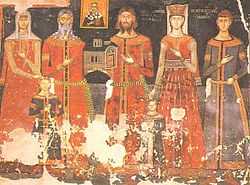Uglješa Vlatković
| Uglješa Vlatković | |
|---|---|
 Possible representation of Uglješa Vlatković as a boy, middle of the 14th century, monastery Psača near Kriva Palanka, Republic of Macedonia | |
| Predecessor | Vlatko Paskačić |
|
Issue
Stefan Paskačić (died 1400) | |
|
Full name
Угљеша Влатковић | |
|
Titles and styles
Kesar | |
| Family | Paskačić |
| Born | c. 1359 |
| Died | after 1427 |
| Religion | Orthodox Christianity |
Uglješa Vlatković (Serbian: Угљеша Влатковић) (c. 1359 – after 1427) was a Serbian nobleman from the late 14th and early 15th centuries. He had the title of kesar (caesar) and ruled over the area of Inogošt (today Surdulica), Preševo and Vranje.
His grandfather Knez Paskač and his father Sevastokrator Vlatko Paskačić (House of Paskačić), were both nobles of Emperor Dušan the Mighty and ruled over the border areas between Republic of Serbia and Republic of Macedonia, including Slavište župa. His family built Psača monastery with the church of Saint Nicholas, around 1354. His biography was written at the end of the 1360s, and one of the boys portrayed on the fresco could be Uglješa.
Uglješa received the title of caesar when he was a boy from the Emperor Uroš the Weak,[1] and after his father’s death most of his lands were usurped by the Dejanović brothers.[1][2] After the Battle of Rovine in 1395, he probably managed to retake his father’s land and became a vassal of the Ottoman Sultan. It is mentioned that at the beginning of the 15th century he gave one church to the Hilandar monastery.
It isn't known if he participated in the Battle of Ankara, but he joined Ottoman forces sent by Süleyman Çelebi. Their goal was to merge with forces of Branković and prevent the return of Stefan Lazarević in Serbia. On 21 November 1402, the Battle of Gračanica happened. Caesar Uglješa, who was the vassal of Ottomans, knew about their battle plans and informed Stefan Lazarević.[1] At the very beginning of the battle, he defected to the Lazarević’s side and considerably contributed to his victory. As a reward for his conduct, Despot Stefan confirmed his authority over his father’s lands and became Stefan’s vassal.
Over the years, Uglješa was a faithful vassal of Stefan Lazarević and with his forces participated in the Battle of Kosmidion on 15 June 1410. Byzantine sources mentioned him as part of Stefan Lazarević's delegation, who went to Constantinople on the Emperor Manuel II’s invitation. In the 1412, his lands were attacked by the forces of Musa Çelebi. Çelebi’s forces marched across the Čemernik, sacked Vranje and attacked Novo Brdo, and Uglješa itself barely managed to retreat alive.[1]
After Stefan’s death, Constantine of Kostenets moved to the court of Uglješa Vlatković and lived there for some time.[1] He had son Stefan, who died c. 1400 and was buried in Ljubostinja monastery.[3]
References
- ↑ 1.0 1.1 1.2 1.3 1.4 Grupa autora (1994). Istorija srpskog naroda. 1371 (Drugo izd. ed.). Beograd: Srpska književna zadruga. ISBN 8637904769.
- ↑ Šuica, Marko (2000). Nemirno doba srpskog srednjeg veka : vlastela srpskih oblastnih gospodara. Beograd: Javno Preduzeće Službeni List SRJ. ISBN 8635504526.
- ↑ priređivać Dušan Mrđenović ; ..., priređivać Dušan Mrđenović ; ... komentari uz rodoslovne tablice ... Dušan Spasić, Dušan Palavestra (1991). Rodoslovne tablice i grbovi srpskih dinastija i vlastele (2. dop. i proš. izd. ed.). Beograd: Bata. ISBN 8676850070.